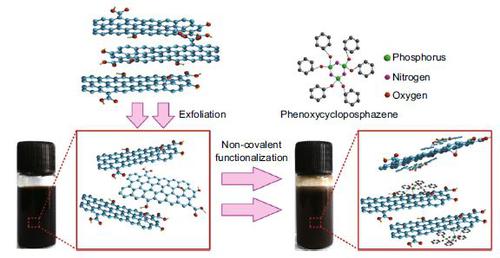Non-covalently Functionalized Graphene Oxide-Based Coating to Enhance Thermal Stability and Flame Retardancy of PVA Film
Wenhua Chen, Pengju Liu, Lizhen Min, Yiming Zhou, Yuan Liu[1], Qi Wang, Wenfeng Duan
Index: 10.1007/s40820-018-0190-8
Full Text: HTML
Abstract

The synergistic effect of conventional flame-retardant elements and graphene has received extensive attention in the development of a new class of flame retardants. Compared to covalent modification, the non-covalent strategy is simpler and expeditious, and entirely preserves the original quality of graphene. Thus, non-covalently functionalized graphene oxide (FGO) with a phosphorus-nitrogen compound was successfully prepared via a one-pot process in this study. Polyethyleneimine (PEI) and FGO were alternatively deposited on the surface of a poly(vinyl alcohol) (PVA) film via layer-by-layer (LBL) assembly driven by electrostatic interaction, imparting excellent flame retardancy to the coated PVA film. The multilayer FGO-based coating formed a protective shield encapsulating the PVA matrix, effectively blocking the transfer of heat and mass during combustion. The coated PVA has a higher initial decomposition temperature of about 260 °C and a nearly 60% reduction in total heat release than neat PVA does. Our results may have a promising prospect for flame retardant polymers.
|
Metal-Organic Framework-Assisted Synthesis of Compact Fe2O3 ...
2018-03-11 [10.1007/s40820-018-0197-1] |
|
Formamidinium Lead Bromide Perovskite Microcrystals for Sens...
2018-03-05 [10.1007/s40820-018-0196-2] |
|
Layer-by-Layer Assembled Bacterial Cellulose/Graphene Oxide ...
2018-02-27 [10.1007/s40820-018-0195-3] |
|
Noninvasive Label-Free Detection of Cortisol and Lactate Usi...
2018-01-23 [10.1007/s40820-018-0193-5] |
|
A Review: Enhanced Anodes of Li/Na-Ion Batteries Based on Yo...
2018-01-17 [10.1007/s40820-018-0194-4] |